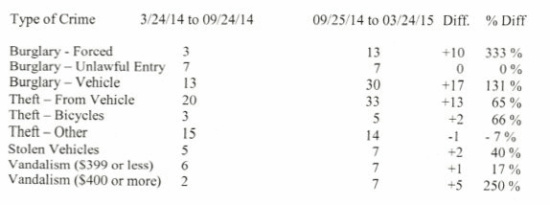This week, the Eureka Police Department will be formally launching a six-month experiment on the city’s West Side. The goal: To see if a neighborhood more engaged with its own problems can help lower the crime rate.
“Project NOW” (the acronym is for “Neighborhoods on Watch”) will take a close look at the area of the city bounded by Seventh, 14th, A and H streets between this month and late October. During that time, the police department hopes to educate and organize residents of the area – historically, one of the neighborhoods most troubled by crime – so that they may play a more active role in making it safer.
Captain Brian Stephens, who is spearheading the project, told the Outpost yesterday that the police department will be training the area’s neighborhood watch groups and other residents on how to better keep an eye on their blocks. He and others with the department will lead some “neighborhood walks,” in which they’ll be showing locals how to spot potential troubles. The department will develop some leaflets that explain what sorts of things should be reported to the police. Department employees will go door-to-door throughout the area, informing residents how they can get involved with neighborhood watch.
Stephens emphasized that he isn’t asking citizens to become cops, and he said that anyone in the neighborhood can participate – you don’t have to be a “young buck who can take care of yourself.”
“We’re not asking you to fight crime,” Stephens said. “We’re just asking you to walk in your neighborhood, to have a phone or a notebook available, and to relay things to us.”
While the project is underway, the police department plans to keep a close eye on the number of calls for service and crimes committed in the study area, to test its hypothesis that a more actively engaged neighborhood can bring down crime more or less on its own.
At an organizational meeting for the project last week, Eureka Police Chief Andy Mills said that during the study period the police department itself will do almost nothing different, apart from the resources it will put toward community organizing. Patrols will stay the same, and the department will continue to respond to calls in the same way that it has in the past.
“If this works, we want to replicate it and transport it throughout the city,” he said. “If we can do it here, we can do it anywhere.”
The EPD is inviting people who live near Jefferson School to join them on a kickoff “neighborhood walk” tonight. The area’s own neighborhood watch group will be joined by representatives from other neighborhood watch groups around the city. They’ll be meeting at 6 p.m. at the Jefferson Project.
In about a month, Stephens said, Project NOW will hold a larger meeting of residents throughout the study area, which will have more information about the project’s aims and how residents can get involved.
In the meanwhile, the EPD compiled some baseline statistics about crime in the study area over the last year, so that there will be something to compare the post-Project NOW numbers against:
And for what it’s worth, since Aug. 2013 your Lost Coast Outpost has been scraping up data that the EPD publishes to CrimeReports.com. You can find that data for the Project NOW study area in the map embedded below. It should include all crime reports and arrest reports taken within the bounds of the study area between Aug. 12, 2013 and the present day. There’ll be some other stuff in there too — traffic accidents, etc.
Use the navigation tools in the upper-right corner of the box to narrow the time frame you’d like to search, or to narrow by incident type. Click on the marker to get more details.


CLICK TO MANAGE